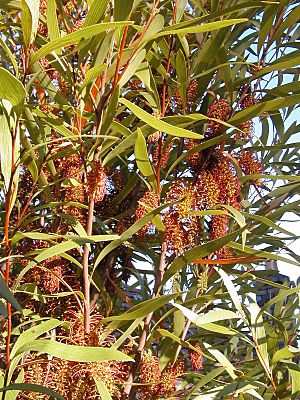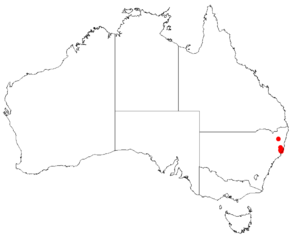Hakea archaeoides facts for kids
Quick facts for kids Hakea archaeoides |
|
|---|---|
 |
|
| Conservation status | |
| Scientific classification | |
| Genus: |
Hakea
|
| Species: |
archaeoides
|
 |
|
| Occurrence data from Australasian Virtual Herbarium | |
The Big Nellie Hakea (scientific name: Hakea archaeoides) is a tall shrub or small tree. It's special because it only grows in certain forest areas on the north coast of New South Wales, Australia. When it blooms, you'll see beautiful clusters of red and greenish-yellow flowers.
Contents
What Does the Big Nellie Hakea Look Like?
The Big Nellie Hakea is a shrub that can grow up to 7 meters (about 23 feet) tall and 4 meters (about 13 feet) wide. It has many stems and can regrow from a special woody base called a lignotuber if there's a fire.
When the plant is young, its small branches and new leaves are covered in soft, red-brown hairs. The leaves are long and narrow, usually between 7.5 and 28.5 centimeters (about 3 to 11 inches) long. They slowly narrow to a sharp point.
Flowers and Fruit
This plant produces many flowers, often 70 to 110 or more, in each cluster. These clusters hang down from where the leaves meet the stem. The flowers are a mix of red and greenish-yellow. They usually appear from spring to early summer.
After the flowers bloom, the plant grows woody fruits. These fruits are shaped like an egg and are about 1.5 to 2.2 centimeters (about 0.6 to 0.9 inches) long.
Where Does the Big Nellie Hakea Live?
The Big Nellie Hakea is found only in specific areas of north-eastern New South Wales, Australia. You can find it near the towns of Taree and Wauchope. It prefers to grow on hill slopes in wet sclerophyll forests and rainforests.
Why Is This Plant Special?
The Big Nellie Hakea was first officially described in 1999 by a scientist named William Barker. He named it archaeoides because it looks similar to some of the very first types of hakea plants.
Is the Big Nellie Hakea Protected?
Yes, this hakea is considered "vulnerable." This means it needs protection because its numbers are decreasing. Both the Australian Government and the New South Wales government have laws to help protect it. These laws are the Environment Protection and Biodiversity Conservation Act 1999 and the Biodiversity Conservation Act 2016.
See also
 In Spanish: Hakea archaeoides para niños
In Spanish: Hakea archaeoides para niños


